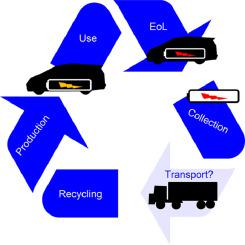Resources, Conservation and Recycling ( IF 11.2 ) Pub Date : 2021-07-09 , DOI: 10.1016/j.resconrec.2021.105755 Margaret Slattery 1 , Jessica Dunn 1 , Alissa Kendall 2

|
The market for electric vehicles (EVs) has grown exponentially over the past decade, largely driven by ambitious sales targets in regions around the world. At end-of-life (EoL), these batteries must be managed properly to maximize reuse and recycling, which requires an efficient and safe collection and transportation system; however, the logistics of transporting EoL batteries are rarely examined in depth in scholarly research. In this paper, we conduct a critical review of the peer-reviewed literature on EV traction battery reuse and recycling to assess how transportation is represented. We find that among 60 studies identified, 70% mentioned collection and transportation as a challenge to battery reuse or recycling, and 63% identified a need for policy or further research related to collection and transportation. Among 17 papers that focus on cost, estimates for transportation costs vary widely among studies, from more than five dollars per kg to less than 30 cents, representing, on average, 41% of the total cost of recycling. Studies that examined the environmental impact of EoL transportation suggest it contributes 1–3.5% of life cycle GHG emissions for a recycled battery. In response to the limited and highly variable treatment of battery EoL transportation, the literature review is followed by contextual information about the United States, including the regulatory framework and existing network for EoL batteries. Recommendations for future study include place-specific research on optimal facility siting that considers both existing and projected infrastructure, and which reflects costs and environmental and social impacts at local scales.
中文翻译:

电动汽车锂离子电池报废运输:文献综述
电动汽车 (EV) 市场在过去十年中呈指数级增长,这主要是受全球各地区雄心勃勃的销售目标的推动。在报废 (EoL) 时,必须妥善管理这些电池,以最大限度地重复使用和回收利用,这需要高效安全的收集和运输系统;然而,在学术研究中很少深入研究运输 EoL 电池的物流。在本文中,我们对有关 EV 牵引电池再利用和回收的同行评审文献进行了批判性审查,以评估运输的表现方式。我们发现,在确定的 60 项研究中,70% 提到收集和运输是电池再利用或回收的挑战,63% 认为需要制定与收集和运输相关的政策或进一步研究。在关注成本的 17 篇论文中,不同研究对运输成本的估计差异很大,从每公斤超过 5 美元到不到 30 美分不等,平均占回收总成本的 41%。检查 EoL 运输对环境影响的研究表明,它对回收电池的生命周期温室气体排放量贡献了 1-3.5%。为了应对电池 EoL 运输的有限且高度可变的处理方式,文献综述之后是有关美国的上下文信息,包括 EoL 电池的监管框架和现有网络。未来研究的建议包括对最佳设施选址的特定地点研究,该研究考虑现有和预计的基础设施,并反映当地规模的成本以及环境和社会影响。不同研究对运输成本的估计差异很大,从每公斤超过 5 美元到不到 30 美分,平均占回收总成本的 41%。检查 EoL 运输对环境影响的研究表明,它对回收电池的生命周期温室气体排放量贡献了 1-3.5%。为了应对电池 EoL 运输的有限且高度可变的处理方式,文献综述之后是有关美国的上下文信息,包括 EoL 电池的监管框架和现有网络。未来研究的建议包括对最佳设施选址的特定地点研究,该研究考虑现有和预计的基础设施,并反映当地规模的成本以及环境和社会影响。不同研究对运输成本的估计差异很大,从每公斤超过 5 美元到不到 30 美分,平均占回收总成本的 41%。检查 EoL 运输对环境影响的研究表明,它对回收电池的生命周期温室气体排放量贡献了 1-3.5%。为了应对电池 EoL 运输的有限且高度可变的处理方式,文献综述之后是有关美国的上下文信息,包括 EoL 电池的监管框架和现有网络。未来研究的建议包括对最佳设施选址的特定地点研究,该研究考虑现有和预计的基础设施,并反映当地规模的成本以及环境和社会影响。









































 京公网安备 11010802027423号
京公网安备 11010802027423号